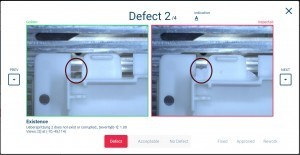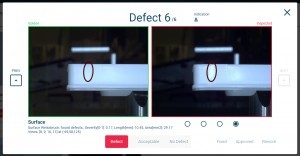High product quality and accuracy is also a must in the production of plastic parts. However, especially in series production, it is extremely challenging to consistently and reproducibly detect production errors and qualitative shortcomings when the cycle rate is high. The Kitov One hybrid 2D/3D robotic vision system enables 100% inspection of all parts and relieves employees of tedious and monotonous tasks.
 Overmolding detected by Kitov One. "Many companies in the plastics industry manufacture high-quality and complex products for the automotive, medical technology, aviation and mechanical engineering sectors at very high cycle rates. In order to guarantee consistently high quality, the production processes must meet high standards in terms of accuracy and speed. Overmolding, white breakage or other inaccuracies and undesirable surface changes must therefore always be reliably detected," explains Olaf Römer, Managing Director of ATEcare Service GmbH Co.KG.
Overmolding detected by Kitov One. "Many companies in the plastics industry manufacture high-quality and complex products for the automotive, medical technology, aviation and mechanical engineering sectors at very high cycle rates. In order to guarantee consistently high quality, the production processes must meet high standards in terms of accuracy and speed. Overmolding, white breakage or other inaccuracies and undesirable surface changes must therefore always be reliably detected," explains Olaf Römer, Managing Director of ATEcare Service GmbH Co.KG.
Despite this, quality assurance in modern manufacturing companies still often involves employees manually turning each part in all directions and checking various visible criteria with the human eye. However, this inspection must be accurate, reliable and consistent, especially for plastic parts that are assembled into a finished product. This is not always guaranteed in a manual inspection, as employees can give different and subjectively influenced assessments depending on their mood and mood of the day, fatigue and loss of concentration due to the monotonous activity while maintaining comparable quality. This leads to inconsistent test results. Typical defects in plastic parts are, for example, plastic tongues that are not engaged, plastic deformations and over-molding, missing or damaged metal inlays, clips or other fastening elements, incorrectly printed or attached labels, missing rubber components or scratches on the surface.
"Manual quality control is of course time-consuming and error-prone, as something can easily be overlooked. Because a faulty component often leads to the rejection of the entire product by the client, a 100% inspection must be guaranteed here, which can only be achieved to a limited extent with a manual inspection," Römer continues. In his view, only a fully automatic, reproducible and intelligent inspection method can provide a remedy here. Römer and his company are sales partners of Kitov Systems, the manufacturer of the robot-based hybrid vision system Kitov One, which combines 2D, 3D and deep learning technologies to enable automated inspection tasks that were previously considered too complex to be carried out quickly, precisely and reliably. To ensure effective inspection, Kitov One combines its sophisticated camera and lighting technology with the flexibility of a robot and a turntable that can rotate certain inspection features towards the camera, further reducing cycle time.
Normally, creating an inspection plan for a robot-based vision system would require extensive specialized knowledge in robotics, image processing and programming. It would take not just days but weeks to complete such a plan, depending on the number of features to be inspected.
 In addition, subsequent changes to the inspection plan would require the use of robotics experts and image processing specialists at the customer's site, which not every company can or wants to hire.With KITOV One, manufacturers of plastic parts can create an inspection plan for the automatic optical inspection of their products within a few hours. Any necessary changes or adjustments to the inspection plan can be carried out within a very short time. ATEcare helps to train employees and supports its customers in implementing the first applications.
In addition, subsequent changes to the inspection plan would require the use of robotics experts and image processing specialists at the customer's site, which not every company can or wants to hire.With KITOV One, manufacturers of plastic parts can create an inspection plan for the automatic optical inspection of their products within a few hours. Any necessary changes or adjustments to the inspection plan can be carried out within a very short time. ATEcare helps to train employees and supports its customers in implementing the first applications.
The results of the vision system also help companies to avoid inaccuracies in the inspection results of manual inspection, as manual inspectors do not always have the same definition for every defect. Furthermore, defects and quality problems in upstream production processes and assembly steps can be identified so that they can be eliminated at an early stage and reject quantities can be reduced. "This enables us to achieve amortization of the entire system within a few months," says Römer.
Römer adds: "Kitov One is not just another robot-guided 3D measuring system. Kitov One is a purely visual inspection system that is not yet available in this flexible form in today's industrial production. The automated visual inspection can recognize and measure all parameters that are selected or taught via the software. This means that the inspection is individually tailored to each product. Both the assembly and the finished end product can be checked before installation or customer handover. The system supports the teach-in process with many automatic functions and is also constantly learning with the help of deep learning, so that the inspection routines are continuously optimized automatically. In this way, the pseudo error rate is gradually reduced to a negligible minimum. All test results are continuously documented and saved, so that the system enables traceable, uniform and person-independent quality control (traceability).
It should be emphasized that a system like the Kitov One can be trained using AI to classify defects and derive a decision from this. "In this way, the user can train the software system to learn the difference between a good and a bad test specimen. The software then analyzes the images and distinguishes the relationships between the features in a target/actual comparison in order to derive whether the test specimen is good or bad. The Kitov One also derives future good/bad decisions from these characteristics," Römer continues. Such deep learning behavior can, for example, capture thousands of images of a screw and not only knows where it is, but also whether it meets the quality requirements. "This means that the system not only knows what to look for, but can also decide whether the result is within the specified tolerances," explains Römer.


